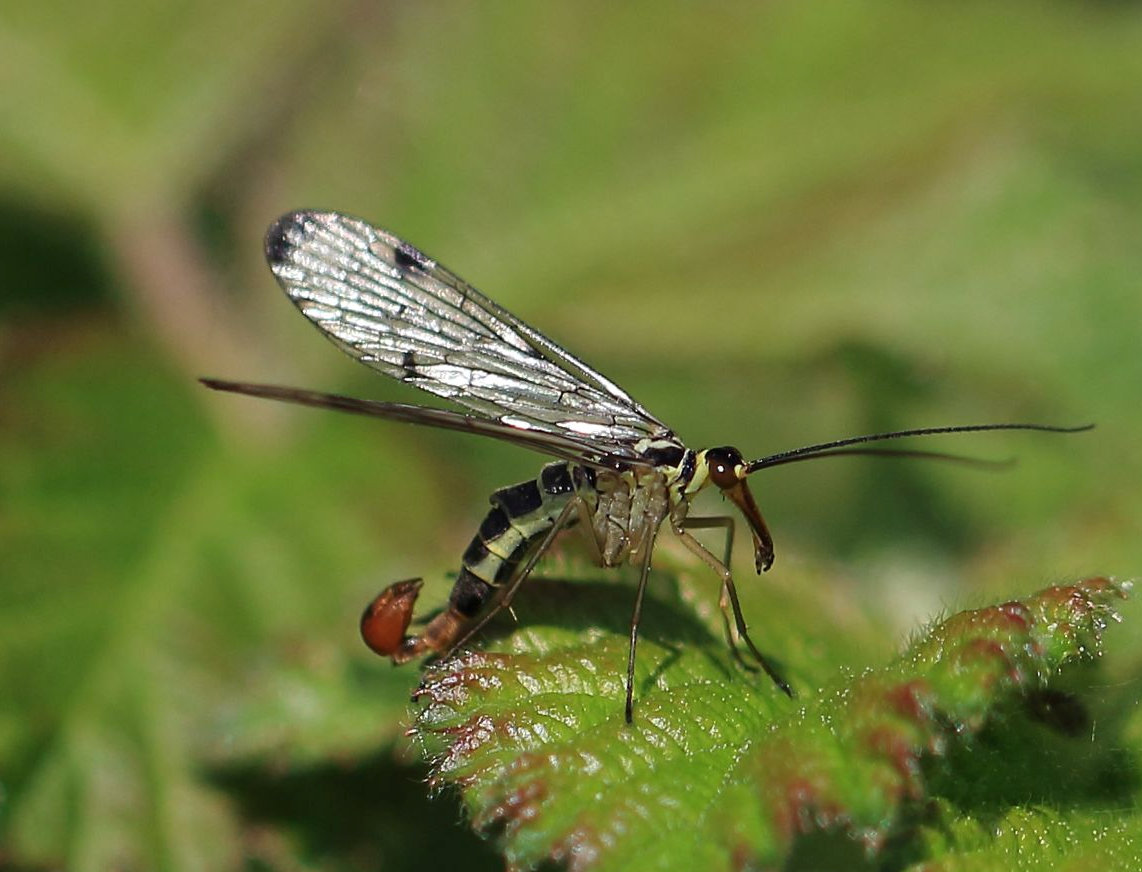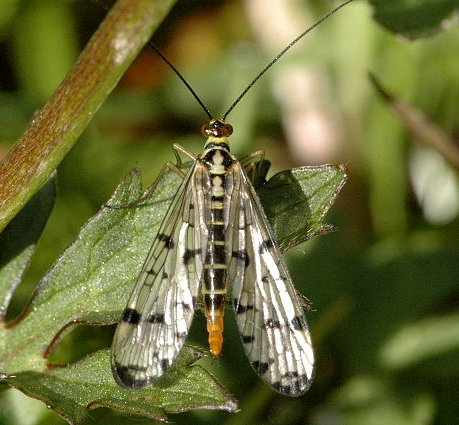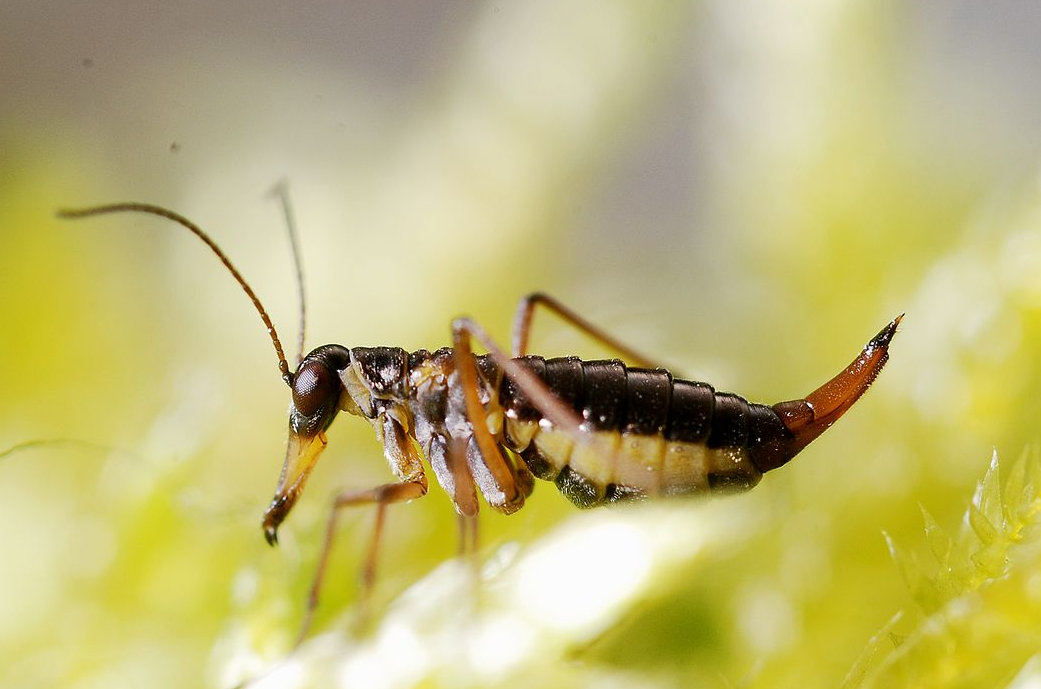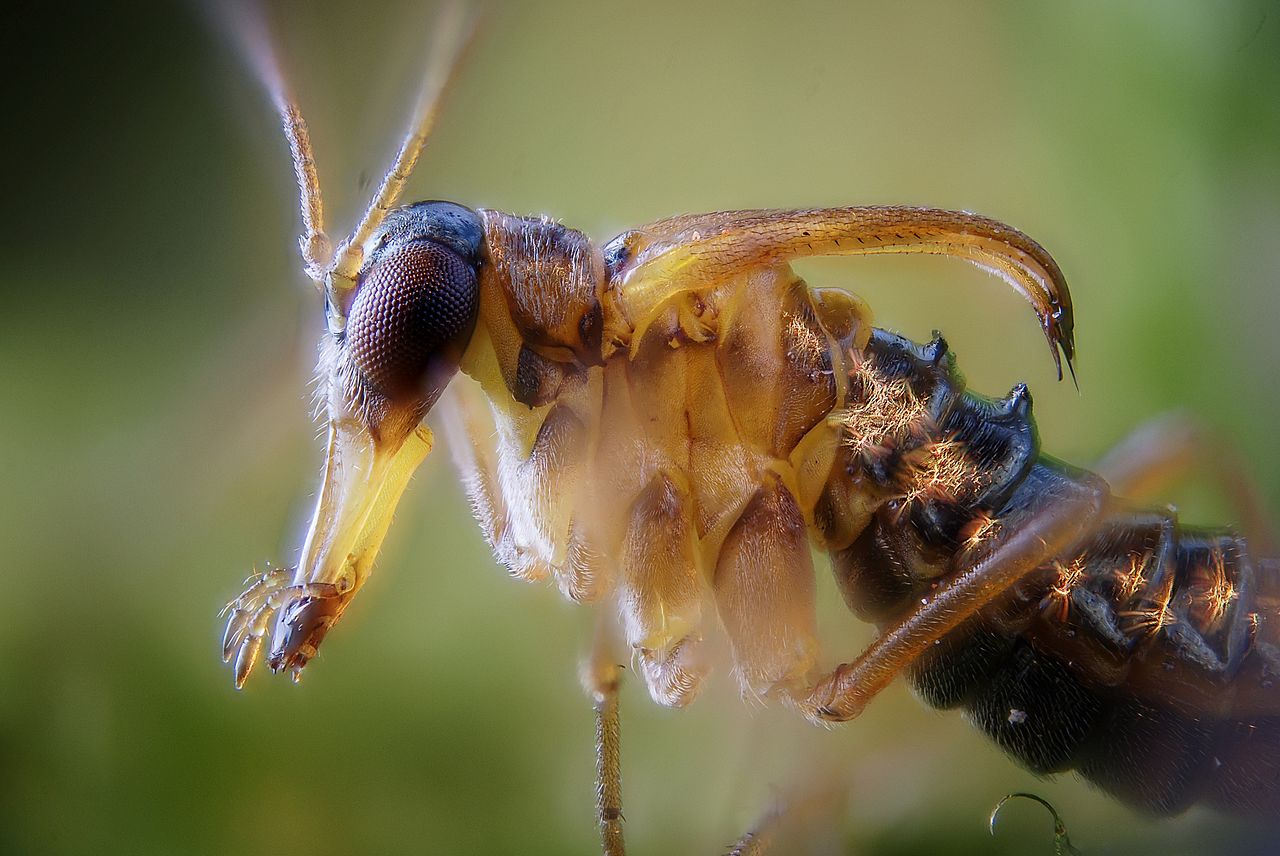Scorpion flies and snow fleas
Scorpion flies, such as Panorpa species, belong to the insect order Mecoptera. There are about 600 species around the world, mostly tropical. This is an old group of endopterygote insects, possibly ancestral to the butterflies and moths, lacewings, true flies and fleas. The adults are distinctive, having elongated heads with a pair of jaws on the lower edge. Scorpion flies are about 12-15mm long but the genitalia on the males, when uncurled, can add another 5mm. They are pale yellow with black markings, with the tip of the abdomen being orange brown. Scorpion flies have long thread-like antennae and their membranous wings are strongly marked with blackish brown blotches. The wingspan is 25-30mm.
The common name of this group of insects is based on the appearance of the males. They have large genitalia that are held up over the rear end of their bodies, and looking like a scorpion’s sting. They are, however, entirely harmless and incapable of stinging. The females have a tubular end to their abdomens but are otherwise similar in appearance to males.
Species in Britain and Ireland
There are three species of scorpion fly in Britain. Panorpa cognata is the least common and occurs in England and Wales. Panorpa communis and P. germanica are widely distributed in England, Scotland and Wales but only the latter has been recorded in Ireland. The snow flea also appears to be absent from Ireland.
Britain has one other Mecopteran species, Boreus hyemalis, commonly known as the snow flea. It lives and feeds in mosses and is active as adults during the winter, when it is sometimes seen walking over snow-covered ground, hence its common name. It is only 5mm long. The female has tiny vestigial wings, while the male’s wings are spine-like structures. They share the elongated head of the panorpids.
Snow flea Boreus hyemalis. The female on the left has no visible wings, but has a long sabre-like ovipositer. The male on the right shows the bizarre spike like wings, incapable of flight.
Biology
Little is known about the diet of scorpion fly larvae but it is thought that they are scavengers that feed on dead plant and animal remains in the soil. Adult scorpion flies feed primarily on dead insects and they will sometimes take them from spiders’ webs.
Life cycle
Male scorpion flies attract mates by releasing a pheromone from their abdomens. As part of the mating process, the male will present the female with a gift of a food parcel in the form of a chewed up insect. Scorpion flies have one generation a year and they mate in late spring-early summer. Batches of eggs are deposited in the soil. These hatch into larvae that resemble caterpillars of butterflies and moths. When fully grown, they pupate and overwinter in the soil.
Role of scorpion flies in gardens
Scorpion flies are scavengers that help recycle dead invertebrates and plant material.
Other sources of information
Websites
Website of the Lacewing and allies recording scheme.
Amateur Entomologists' Society page on Mecoptera
Book
Plant, C. W. A key to the adults of British lacewings and allies. A Field Studies Council AIDGAP key, Preston Montford, Shrewsbury
Page text drafted by Andrew Halstead, reviewed by Andrew Salisbury, compiled by Steve Head


Above: scorpionfly Panorpa germanica, Left: male with large upturned genitalia also showing the very long "beak" with jaws. Right: female showing the distinctive wing pattern.
Left: Panorpa communis male
.jpg)


Scorpion flies and snow fleas
Scorpion flies, such as Panorpa species, belong to the insect order Mecoptera. There are about 600 species around the world, mostly tropical. This is an old group of endopterygote insects, possibly ancestral to the butterflies and moths, lacewings, true flies and fleas. The adults are distinctive, having elongated heads with a pair of jaws on the lower edge. Scorpion flies are about 12-15mm long but the genitalia on the males, when uncurled, can add another 5mm. They are pale yellow with black markings, with the tip of the abdomen being orange brown. Scorpion flies have long thread-like antennae and their membranous wings are strongly marked with blackish brown blotches. The wingspan is 25-30mm.
The common name of this group of insects is based on the appearance of the males. They have large genitalia that are held up over the rear end of their bodies, and looking like a scorpion’s sting. They are, however, entirely harmless and incapable of stinging. The females have a tubular end to their abdomens but are otherwise similar in appearance to males.
Species in Britain and Ireland
There are three species of scorpion fly in Britain. Panorpa cognata is the least common and occurs in England and Wales. Panorpa communis and P. germanica are widely distributed in England, Scotland and Wales but only the latter has been recorded in Ireland. The snow flea also appears to be absent from Ireland.
Britain has one other Mecopteran species, Boreus hyemalis, commonly known as the snow flea. It lives and feeds in mosses and is active as adults during the winter, when it is sometimes seen walking over snow-covered ground, hence its common name. It is only 5mm long. The female has tiny vestigial wings, while the male’s wings are spine-like structures. They share the elongated head of the panorpids.


.jpg)
Above: scorpionfly Panorpa germanica, Left: male with large upturned genitalia also showing the very long "beak" with jaws. Right: female showing the distinctive wing pattern.
Left: Panorpa communis male
Snow flea Boreus hyemalis. The female on the left has no visible wings, but has a long sabre-like ovipositer. The male on the right shows the bizarre spike like wings, incapable of flight.
Biology
Little is known about the diet of scorpion fly larvae but it is thought that they are scavengers that feed on dead plant and animal remains in the soil. Adult scorpion flies feed primarily on dead insects and they will sometimes take them from spiders’ webs.
Life cycle
Male scorpion flies attract mates by releasing a pheromone from their abdomens. As part of the mating process, the male will present the female with a gift of a food parcel in the form of a chewed up insect. Scorpion flies have one generation a year and they mate in late spring-early summer. Batches of eggs are deposited in the soil. These hatch into larvae that resemble caterpillars of butterflies and moths. When fully grown, they pupate and overwinter in the soil.
Role of scorpion flies in gardens
Scorpion flies are scavengers that help recycle dead invertebrates and plant material.
Other sources of information
Websites
Website of the Lacewing and allies recording scheme.
Book
Plant, C. W. A key to the adults of British lacewings and allies. A Field Studies Council AIDGAP key, Preston Montford, Shrewsbury
Page text drafted by Andrew Halstead, reviewed by Andrew Salisbury, compiled by Steve Head


- Home
- Garden Wildlife
- Insects
- Scorpion flies












